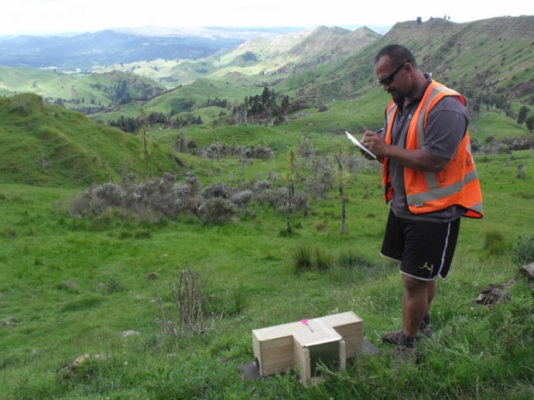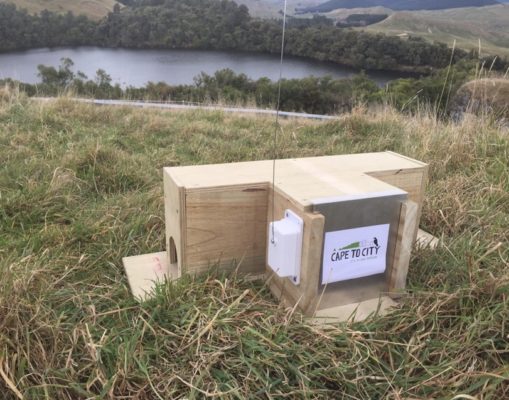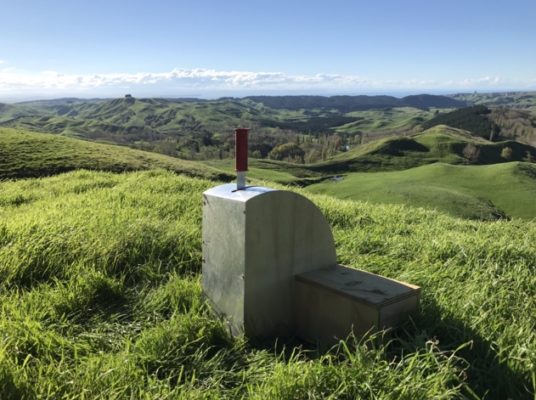Inventing a new kind of trap can be a slow kind of process. Sometimes you don’t even know you’re on that journey until you’re well on your way. Take the podiTRAP for example. It’s probably still a year away from commercial release, but the podiTRAP may well be ‘the tool to use’ in the future.

“I never expected it to be where it is now,” says its inventor, Pouri Rakete-Stones. “It’s evolved into this big monster project!”
Pouri is an engineer by trade. He spent 10 years as a fitter/welder, doing research and development work on machinery, before getting involved with Hawkes Bay kiwi conservation and outdoor education organisation ECOED in 2010.
Not only did engineering and conservation come together at that point, but that was when Pouri and his wife Wendy first worked with then-General Manager Al Bramley. Al is currently CEO of ZIP (Zero Invasive Predators). Pouri, Wendy and Al also worked together during the early development stage of the Poutiri Ao ō Tāne project, a sister project to Hawkes Bay’s Cape to City. It was on this project that they started talking about what sort of trap they wanted to use for their 8000 hectares predator control programme.
“We had the idea of using a run through tunnel trap,” Pouri explains, “So I started working in my garage to see what I came up with. We came up with some ideas of what we wanted. It had to have good usability. It needed to be easy for farmers, landowners or even volunteers to service and the trap needed to be DOC 250 size because we wanted to include ferrets in the target species. So I developed a flip open lid for the tunnel so that the whole thing folds open.”

Kiwi were also a factor in the tunnel design.
“We had to consider the length of the tunnel and the size of the entrance hole so that kiwi couldn’t reach the trap inside,” says Pouri.
The team then tested the tunnels, with DOC 250 traps inside, against the standard DOC 250 setup, with 50% of each trap type in their predator control network.
“The data collected over the trial showed that tunnels were the way to go,” says Pouri. “The tunnels were catching more ferrets and 2 times as many rats. The number of stoats caught in each was about the same.”
When the Cape to City project started in 2015, there were aspects of the prototype traps that the project team wanted to keep – the run through tunnel and the easy, flip-open lid – but other factors that still needed to be improved.
“The traps needed to be easy to set,” says Pouri. “The DOC 250 traps need a tool to set. They can be dangerous and hard for volunteers to set.”
Pouri’s solution was to change the design, introducing a handle.

“The handle on top of the tunnel was attached to the DOC 250 trap inside so that the trap could be set from outside,” he explains. “The handle on the outside also works as a ‘flag’. When the trap is set, the handle is up, so when you’re servicing the network you don’t need to stop at all the tunnels. It makes in quicker and more efficient to service the trapping network.”
The new handle feature worked so well that even Pouri’s 12-year-old daughter could safely set the traps.
“It’s also locking,” says Pouri. “When the handle is up and the trap is set, you can’t flip open the lid.
The new tunnel-trap design was trialled in the Cape to City project during 2015-2016. In mid-2015 family-owned Dannevirke sheet-metal manufacturing company Metalform also became involved in development of the product.
“Our role is take ideas and commercialise them,” explains Campbell Easton, Managing Director of Metalform. “We’ve taken all the knowledge that Pouri has, the years of tinkering and refining an original ‘bespoke’ trap and we’ve used our expertise to develop a commercially viable product which can be mass-manufactured accurately and easily. We’ve got a lot of automatic robotic welding and laser-cutting equipment,” he adds. “With the podiTRAP, the key thing has been to ensure that there is a very consistent trigger weight.”
“I hadn’t been thinking in terms of product manufacture,” Pouri says. “Metalform helped develop a new shape and box size so that it was robust and stronger – but still keeping the key design features.”
While Metalform has manufactured other products for the conservation sector, the podiTRAP is the first kill trap they’ve worked on.
“Years ago the firm used to make something called a ‘jam-gun’ for pest control,” says Campbell, “And nowadays we build componentry for pest-proof fencing, fence capping for the fence at the Cape Kidnappers sanctuary.”
With Metalform on board, the next design step was getting the podiTRAP NAWAC (National Animal Welfare Advisory Committee) tested as a humane trap for killing ferrets – one of the target species in the Cape to City predator control project.
“In 2016 we took the trap to Lincoln and put it through its paces,” says Pouri, “And it failed three times. It was a good process,” he says. “It tested the boundaries and we took it away and sent it back to Metalform and they were really good and made changes in a couple of days. Then it failed again, so we had more ideas on how to change it, like increasing the spring strength.”
As the spring size increased, the trap then needed to be re-engineered for the increased spring tension. By the time the podiTRAP passed the NAWAC test as a ferret trap on its 4th test cycle the springs were 4 x stronger than a standard DOC 250 trap. The standard ferret test weight for the NAWAC test has recently risen from 0.900kg to 1.800kg, this makes the new NAWAC test standard much more difficult to pass.
“It was a 3 month process,” says Pouri, “And the 4th time it was tested it passed with flying colours. It’s now got very big, strong springs and the podiTRAP, along with the DOC 250 which was NAWAC-tested about 10 years ago, are the only traps which have passed the NAWAC test for ferrets.”
Other modifications to the trap included a redesigned shape for the handle so it was easy to reset. Once the design had got its NAWAC ‘tick’, 1000 traps were made up by Metalform and are currently being field-tested in the Cape to City project.
“There have been a few little bumps,” says Pouri. “We’ve now got the trigger setting sorted so that when you pull the handle back, the trap sets every time. And initially the traps had no bases. They were fastened to the ground. But there were problems with grass growing through, so now we’ve got a plastic base and that’s working well.”
The design process continues with Metalform now working on the architecture of the container.
“The last step of the process is to get the plastic injection mould tooling done,” says Campbell.
“Metalform came up with a design that was plastic-injected, not made of plywood, so it lasts longer,” Pouri adds. “They’ve made a 3D printed version and now they’re fiddling with the design so that it’s nice and not bulky,” he explains. “They’re also working on a modularised design so that the traps stack on top of each other and can be stacked on a quad-bike okay. With the ply traps you could carry 3 or 4 at a time but with the new, modularised plastic they’re light and you can probably carry 20 at a time.”
It’s an important practical modification as the product comes closer to being commercially released.
“Metalform have been fantastic with the redesigns,” says Pouri. “In the future, it will be a fantastic trap moving forward, especially for big male ferrets. It’s about 95% ready now but we’re finishing work on the design of the outside container. By the middle of next year it might be on the market. We don’t want to release it prematurely. It has to be 100% ready first.”
So keep an eye out next year for the launch of the podiTRAP – a product that has been seven years already in the design and the making.

